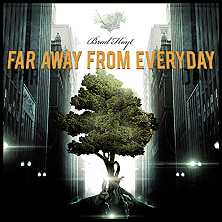 God
bless the piano player who can join forces with guitarists of all
persuasions and come up with an album that’s truly different
and magical. Case in point is pianist / guitarist Brad Hoyt,
who came to light thanks to his work with harp guitarist Gregg
Miner on Gregg’s illustrious Harp Guitar Music label. Well,
that same label has a new for 2013 CD out by Brad entitled Far
Away From Everyday. Produced by Brad and Gregg, the
14 track all instrumental CD falls somewhere between the wide range
of instrumental New Age and Americana folk-jazz. On board on Brad’s
latest musical venture are a number of great musicians including guitarists
galore. In addition to his piano work, Brad also plays a mean harp
guitar. When we talk about harp guitar, we’re talking extended
range guitars that sometimes border on 30 strings per guitar. Hence,
the harp comparison. The number of musicians contributing to Far
Away From Everyday is truly impressive, including those who’ve
already played on albums released by Gregg’s HGM label. In addition
to the amazing harp guitarists here are American jazz-rock guitar
hero Phil Keaggy, harmonica wiz Howard Levy, fretless
bass ace Michael Manring and of course harp guitar master Gregg
Miner himself. Far Away From Everyday sounds great and offers
a sublime and truly relaxing musical experience that fits in perfectly
with Miner’s harp guitar philosophy. In addition to full color
pics of the various artists participating, the CD booklet also features
track by track notes and detailed liner notes by Brad Hoyt. As far
as meditative instrumental guitar albums go, it doesn’t get much
better than Far Away From Everyday by the multitalented Brad
Hoyt. www.BradHoyt.com
God
bless the piano player who can join forces with guitarists of all
persuasions and come up with an album that’s truly different
and magical. Case in point is pianist / guitarist Brad Hoyt,
who came to light thanks to his work with harp guitarist Gregg
Miner on Gregg’s illustrious Harp Guitar Music label. Well,
that same label has a new for 2013 CD out by Brad entitled Far
Away From Everyday. Produced by Brad and Gregg, the
14 track all instrumental CD falls somewhere between the wide range
of instrumental New Age and Americana folk-jazz. On board on Brad’s
latest musical venture are a number of great musicians including guitarists
galore. In addition to his piano work, Brad also plays a mean harp
guitar. When we talk about harp guitar, we’re talking extended
range guitars that sometimes border on 30 strings per guitar. Hence,
the harp comparison. The number of musicians contributing to Far
Away From Everyday is truly impressive, including those who’ve
already played on albums released by Gregg’s HGM label. In addition
to the amazing harp guitarists here are American jazz-rock guitar
hero Phil Keaggy, harmonica wiz Howard Levy, fretless
bass ace Michael Manring and of course harp guitar master Gregg
Miner himself. Far Away From Everyday sounds great and offers
a sublime and truly relaxing musical experience that fits in perfectly
with Miner’s harp guitar philosophy. In addition to full color
pics of the various artists participating, the CD booklet also features
track by track notes and detailed liner notes by Brad Hoyt. As far
as meditative instrumental guitar albums go, it doesn’t get much
better than Far Away From Everyday by the multitalented Brad
Hoyt. www.BradHoyt.com
mwe3.com presents an interview
with
BRAD HOYT
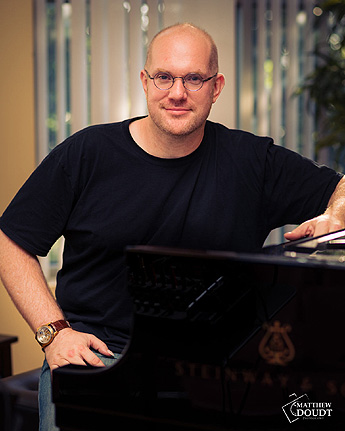 mwe3:
Where are you from originally and where do you live now and what do
you like best about it?
mwe3:
Where are you from originally and where do you live now and what do
you like best about it?
BRAD HOYT: My hometown is Muncie, Indiana. I moved around a
lot after graduating from Ball State in the mid 90s, spending time
in New York City, Aurora, Colorado and Prague in the Czech Republic
before moving back to Indiana. Then a couple years ago, I relocated
back to Colorado. I like the people here and living within driving
distance to the mountains. For me, the effect of looking out over
the mountain range every morning is similar to looking out over the
ocean.
mwe3: What instruments do you play? What were your early musical
studies like and how do you balance your interest in both the keyboard
and harp guitar?
BRAD HOYT: I’ve never tried to balance my interest in
respect to different instruments. I am first and foremost, a pianist.
It’s the instrument I’ve played since before I could talk.
During my college years, I became a marginal guitarist while taking
classical lessons and forcing my fingers to do the basic movements.
My fascination with plucked strings actually started in the recording
studio when I added a plucked piano part to a tune. Since playing
the piano in this manner wasn’t very practical, I later came
up with the idea of finding an instrument that would resemble a ‘portable
plucked piano’. With this in mind, I scoured musical instrument
museums and instrument databases cataloging all kinds of stringed
instruments that might approximate this idea. It was during this time
that I discovered the harp guitar.
The harp guitar that I play today is the result of a four year design
and construction process with master luthier Stephen Sedgwick from
the U.K. His expertise made my drawings a reality and thankfully,
the resulting 30-string harp guitar, which Stephen coined the ‘arpa
viola caipira’ was a success.
I’ve played my harp guitar since 2008 and before and since then,
whatever music I happen to be writing has always dictated what instruments
I decide to play.
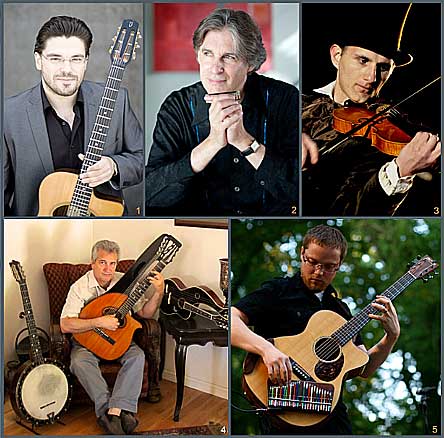 mwe3:
When did you start taking the piano and guitar seriously and how did
you move from guitar to playing harp guitar and for those who might
not know, can you explain a little what a harp guitar is and what
are the challenges of playing it?
mwe3:
When did you start taking the piano and guitar seriously and how did
you move from guitar to playing harp guitar and for those who might
not know, can you explain a little what a harp guitar is and what
are the challenges of playing it?
BRAD HOYT: A harp guitar is a guitar with additional open strings
that are meant to be played. These additional strings can provide
extra bass and treble range to the instrument and can affect the tone
nicely with their sympathetic resonance when they are not being played.
One challenge of playing this instrument is that you must be comfortable
with stretching out your hand to play strings that are far apart.
I think this particular aspect was a little easier for me due to my
experience on piano (playing octaves, etc).
I’ve always wanted to take music seriously. I think the turning
point was when I was a senior in high school. As I was sitting at
the piano, I created a little 8 bar melody with some chords. It was
a short melancholy passage and as I was playing it, I came to the
realization that it wasn’t from somewhere else. Once I recognized
that, I played it over and over again. From that point forward, my
main focus was to try to create something new again, documenting and
recording most of the new pieces I would come up with. I have never
been an outstanding performer. Creating the music was what caused
me to take things more seriously.
Regarding the instruments, I view them as a means to an end - the
end being good music. I never really moved from the standard 6 string
guitar to the harp guitar. Actually, two years before I received my
harp guitar, I found a 10-string Brazilian ‘viola caipira’
(country guitar in Portuguese) that I could play until the harp guitar
was finished. My harp guitar is actually a harp guitar version of
the Brazilian viola caipira so it made since for me to practice first
on the traditional 10-string instrument before transitioning to the
‘arpa viola caipira’.
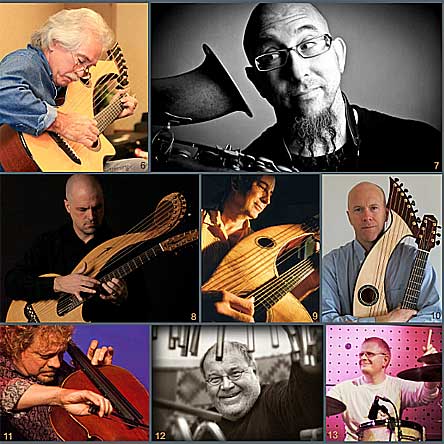 mwe3:
Can you say something about your different instruments? For example
on the Far Away From Everyday track called “Impossible
Liaison” you play piano, harp guitar, something called
“orphica” piano, harpsichord, spinet, ukulele, something
called “Wrenchenspiel” and even 8Di Oboe. Can you say something
about combining all those instruments on one track and what instruments
do you prefer?
mwe3:
Can you say something about your different instruments? For example
on the Far Away From Everyday track called “Impossible
Liaison” you play piano, harp guitar, something called
“orphica” piano, harpsichord, spinet, ukulele, something
called “Wrenchenspiel” and even 8Di Oboe. Can you say something
about combining all those instruments on one track and what instruments
do you prefer?
BRAD HOYT: On this new CD Far Away From Everyday I am
mainly playing some form of keyboard instrument (mostly piano) and
my harp guitar. The instrumentation that I eventually settled with
was dictated by the kind of sound I wanted for the particular music
I was working on. Most of the additional instruments I play beyond
piano and harp guitar are used to add different shades or colour to
the sound.
For example, I used the “Orphica piano” a few times throughout
the CD. This table top ‘portable’ piano was invented by
Leopold Rollig, built in 1798 by Joseph Donal and then deep-sampled
by Nicolay Ketterer at Andreas E. Beurmann’s music room of historical
instruments in Germany about five years ago. When I first played this
instrument, I noticed that the sound of this little piano was very
distinctive and when I started using it in arrangements, I discovered
that it complemented the sound of pianos, guitars and harp guitars
in a very unique way. (See)
In the case of “Impossible Liaison”, the harpsichord,
spinet and other instruments were added because I wanted to create
a ‘Beatlesque’ sound during portions of this recording and
I think these instruments helped with that a lot. Whenever I played
instruments other than piano or harp guitar on this CD, the goal was
always to create a new, unique and usually uncommmon instrumentation
that fit the music that was at the same time new and unique.
mwe3: Your new CD, Far Away From Everyday features a
number of musicians including the album’s co-producer Gregg Miner.
Can you tell us how and when you met Gregg and what were some of the
processes of working together with him on the production of the CD?
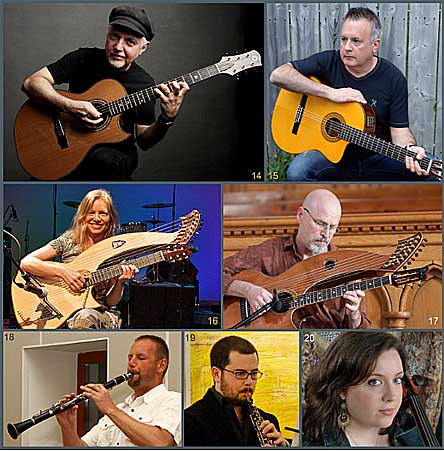 BRAD HOYT:
I met Gregg because of his website – www.harpguitars.net.
During my search for this ‘portable plucked piano’ instrument
I had in my head, I found his website and saw all kinds of harp guitars.
One I noticed had open sub-bass and super-treble strings. This harp
guitar variation seemed to come very close to what I had in mind so
I had a correspondence with him regarding harp guitars and I met him
at the 2nd Harp Guitar Gathering in Williamsburg, Virginia back in
2004.
BRAD HOYT:
I met Gregg because of his website – www.harpguitars.net.
During my search for this ‘portable plucked piano’ instrument
I had in my head, I found his website and saw all kinds of harp guitars.
One I noticed had open sub-bass and super-treble strings. This harp
guitar variation seemed to come very close to what I had in mind so
I had a correspondence with him regarding harp guitars and I met him
at the 2nd Harp Guitar Gathering in Williamsburg, Virginia back in
2004.
Gregg was a co-producer on both Together Alone | Duets with Piano
and Harp Guitar and Far Away From Everyday. Gregg’s
main contribution is that he’s been a great soundboard. It’s
been very helpful to run ideas and recordings by someone who is honest
and discerning. Being able to process critical feedback from someone
with his expertise has been a great asset.
mwe3: What was the recording process like on Far Away From
Everyday? For example were you in the same room with all the musicians
or were the tracks recorded in remote locations and added via overdubbing?
BRAD HOYT: Far Away From Everyday would have been impossible
for me to do 10 years ago. All the musicians who participated on this
CD recorded their parts either in their own studio or a local recording
studio in their area. The advent of quick file transfers via the internet,
wide access to professional quality recording gear and the advances
in music production and technology have had a significant effect on
musical collaboration. The possibilities created by this technological
progression have made this project very rewarding for me.
Here’s one example of what I mean – On the title track “Far
Away From Everyday”, I hear the musical personalities of many
of my friends and musical heroes all playing together on the same
tune. Here’s the breakdown of who contributed to that track:
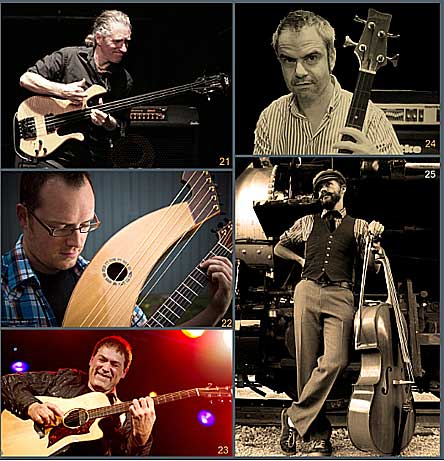 Harmonica
- Played by Howard Levy, the master of diatonic harmonica whom I first
heard when I discovered Béla Fleck and the Flecktones years
ago. He was one of the musicians that I really liked and was influenced
by when I studied music in college. A bit surreal to hear him on this
track…
Harmonica
- Played by Howard Levy, the master of diatonic harmonica whom I first
heard when I discovered Béla Fleck and the Flecktones years
ago. He was one of the musicians that I really liked and was influenced
by when I studied music in college. A bit surreal to hear him on this
track…
Percussion – Played by Jon Crabiel and the late Tom Roady.
Jon is a good friend and percussionist whom I performed with many
times in Indiana. I met Tom in Nashville. He was a very cool guy who
recorded some extra “colours” for me to use during our recording
session during the summer of 2011 with Tom Shinness in Nashville,
TN.
21-string harp guitar – Played by Muriel Anderson. She’s
one of the more accomplished harp guitarists that I’ve ever seen
or heard. We collaborated on the tune “Tonight We Dance”
back in 2009 which I think turned out great.
Fretless bass, drums and clarinet – Played by my bandmates
from Prague: Alexander Jurman, Ales Pavlícek and Pepson Snetivy.
During my time living in the Czech Republic, we played countless gigs
throughout the country. “Far Away From Everyday” was a tune
we actually played back then. I’ve always thought their talent
and creativity was top notch and working with them helped me grow
as a musician. Alex’s bass line is a highlight for me.
Cello – Played by Russick Smith. Last summer I was walking
on the main street in Breckenridge, Colorado and noticed a cellist
playing on the street corner. I couldn’t make out his visage
due to his dipped cap and handle-bar mustache, but his playing was
excellent. Knowing that I needed a cello on this track and struck
by the opportunity of adding yet another unique musical voice to this
music, I introduced myself and two months later, he contributed a
fine cello part.
Oboe – Loreena Hoyt. The first arrangement of the tune
I did back in 2000 called for a small harmony to the clarinet line
played on oboe. I played an oboe patch on a keyboard back then but
this time around, I happen to have a daughter who is a solid up and
coming oboist. She pulled it off nicely!
I played piano on the track.
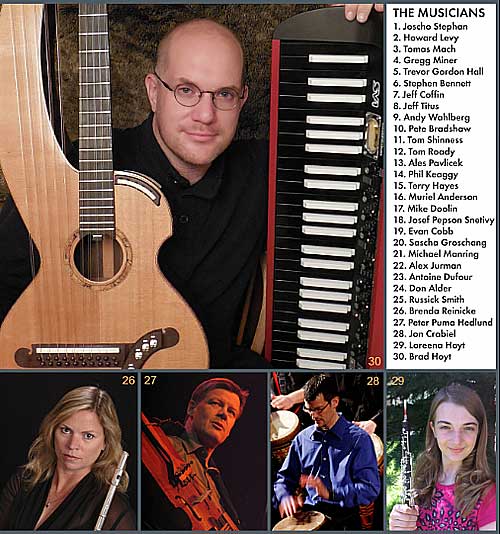 Here’s
a link to where you can hear this track: https://soundcloud.com/brad-hoyt/far-away-from-everyday
Here’s
a link to where you can hear this track: https://soundcloud.com/brad-hoyt/far-away-from-everyday
After all the parts were recorded, it was pretty mind-blowing
for me personally to hear the personalities of all these players that
I’ve known or heard at different times in my life all on one
track…and this is just one track. The other tracks are similar
in this way.
mwe3: When were the tracks on Far Away From Everyday written
and can you tell us something about your song writing style or approach?
Would you say you’re a melody man or more interested in improv?
BRAD HOYT: Some tunes on the CD were written within the last
couple years with the goal of recording them for this project. Others
were written much earlier, then rewritten and revised while others
were written long ago and have essentially remained the same.
Regarding my approach to writing and melody, I’m only interested
in what best fits the purpose of the music. A tune like Sharper’s
Revenge may call for more improvisation while another tune like Beneath
The Iron Gate does not since it’s a slower more deliberate tune
with a distinctive melody. In my opinion, the quality and strength
of your melody is a significant factor that determines how well you
can communicate to the listener. As a composer, an important goal
for me is to create a melody and music that communicates emotions
to others. The better you get at defining and refining your melody
and music, the better you’ll be at getting your point across
that you want to communicate. That’s just my take though. There
are many other approaches out there.
mwe3: How many musicians are featured on the new CD and how
did you choose the various harp guitarists who ended up recording
on the Far Away From Everyday album with you?
BRAD HOYT: Including myself, 30 musicians appear on this CD.
The main criteria for choosing the harp guitarists were that they
were some of my favorite players. I liked their style, musicianship,
etc.
mwe3: Also what was it like working with guitar ace Phil Keaggy
on the track “Look Inside”?
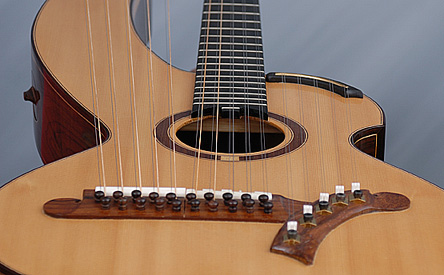 BRAD
HOYT: Great! I wrote the tune ‘Look Inside’ during a
time when I was listening to his CDs Beyond Nature and Find
Me In These Fields. Not only did I love his guitar playing, I
was also effected equally by his compositions and the cello work of
John Catchings. When it came time to record this tune, I thought that
the ideal arrangement would include Phil Keaggy and an amazing cellist.
Then, when I heard Sascha Groschang’s cello on the Barnaby Bright
tune “Yellow Moon”, it all came together. I had to at least
contact both of them to see if we could do this recording. Thankfully
it happened and I love how the music turned out.
BRAD
HOYT: Great! I wrote the tune ‘Look Inside’ during a
time when I was listening to his CDs Beyond Nature and Find
Me In These Fields. Not only did I love his guitar playing, I
was also effected equally by his compositions and the cello work of
John Catchings. When it came time to record this tune, I thought that
the ideal arrangement would include Phil Keaggy and an amazing cellist.
Then, when I heard Sascha Groschang’s cello on the Barnaby Bright
tune “Yellow Moon”, it all came together. I had to at least
contact both of them to see if we could do this recording. Thankfully
it happened and I love how the music turned out.
mwe3: There’s so many different harp guitar (and guitar)
sounds that were recorded for Far Away From Everyday. Was this
deliberate?
BRAD HOYT: My intention when putting together this music was
to create variety so that the listener would be constantly (and pleasantly)
surprised each time they would hear a new track. In the end, the variety
of not just the guitars and harp guitars, but of woodwinds and strings
was more that I originally anticipated. It went beyond my expectations
for sure.
mwe3: Gregg describes making the CD in his liner notes for
Far Away From Everyday and he refers to the music on your album
as being a kind of chamber-jazz. Is that a good way to describe your
new album and how would you describe the music you recorded on Far
Away From Everyday?
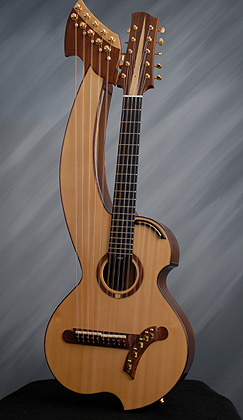 BRAD
HOYT: The best way to categorize the music on the CD would be
to listen to the tracks and then determine what genre each one belongs
to. Each track kinda falls under a different category which makes
it hard to label the CD as a whole. I think Gregg used the term ‘chamber-jazz’
because each track does consist of small ensembles and improvisation
is an important element on every track.
BRAD
HOYT: The best way to categorize the music on the CD would be
to listen to the tracks and then determine what genre each one belongs
to. Each track kinda falls under a different category which makes
it hard to label the CD as a whole. I think Gregg used the term ‘chamber-jazz’
because each track does consist of small ensembles and improvisation
is an important element on every track.
mwe3: Can you tell us about your “harp country guitar”,
the Arpa Viola Caipira, and some of the challenges of playing it as
well as the tuning issues and other details?
BRAD HOYT: My harp guitar is a one-of-a-kind ‘harp guitar
version of the 10-string Brazilian ‘country guitar’ or viola
caipira. The reason I decided to have the harp guitar based on this
instrument is because the viola caipira uses light gauge strings and
the primary (almost exclusive) playing technique of the traditional
instrument is to play with the fingers instead of a pick. The general
idea was to have a harp-like ‘portable piano’ that I could
pluck or play with the fingers (like plucking the strings of a grand
piano). It’s challenge to play but not absurd. There are other
instruments that are far more difficult. For example, the Austrian
concert zither is a nightmare. After I spent a few hours trying to
play it, I wanted to crush it in frustration.
The main challenge during the construction was figuring out how to
fit the tuners for the doubled sub-bass and super treble courses on
the instrument. Both bass and treble ‘harp’ sections consisted
of five doubled courses (10 strings total). For the basses, the builder
Stephen Sedgwick used Steinberger tuners. This was a relatively easy
solution compared to the treble strings. For the trebles, Stephen
created a ‘treble tuner unit’ in the upper bout that contained
the cranks from 10 viola bows. The ends of these cranks were squared
off and I use a special key to tune the strings. It’s like having
a little zither morphed into the body of the instrument. Needless
to say, Stephen knocked it out of the ballpark. It’s an amazing
harp guitar.
Brad wrote two articles about the design and construction of his
instrument here:
mwe3: What else do you like to do outside of music
to keep you relaxed and keep your mind fresh?
BRAD HOYT: I’m from Indiana so I can play basketball.
I’ll be rooting for the Pacers to beat the Heat this year and
win the whole thing. I’d like to see them take home their first
NBA championship. I’ve also been a Colts fan since they moved
to Indy in 1994. I think the best thing you can do to keep your mind
fresh is to exercise, eat right and get enough sleep. My goal this
year is to work at all this stuff.
 mwe3:
What have you got planned for your music as far as writing, recording
and performances on tap for 2014?
mwe3:
What have you got planned for your music as far as writing, recording
and performances on tap for 2014?
BRAD HOYT: My initial plan was to record a ‘trilogy’
of CDs with the first one featuring duets with piano and harp guitar
(“Together Alone”), the second one featuring harp
guitars in ensemble settings (“Far Away From Everyday”)
and the third featuring harp guitars within the whole spectrum, from
solo to symphonic (“There’s The World” – working
title). These particular projects are very time consuming but
very rewarding to finish. So far it’s taken about three years
to produce each one. Knowing this, I’ve decided to dedicate this
year to completing a solo album so there’s not another 3 year
gap between releases. I’m looking forward to incorporating some
new recording and playing techniques on this new solo project that
will expand the type of music I can write with my particular harp
guitar. It’ll be fun!
Thanks to Brad Hoyt @ www.BradHoyt.com



